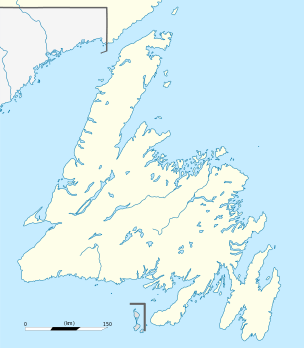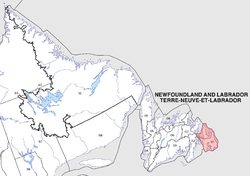Wabana, Newfoundland and Labrador
| Wabana | |
|---|---|
| Town | |
 Wabana Location of Wabana in Newfoundland | |
| Coordinates: 47°39′N 52°56′W / 47.650°N 52.933°W | |
| Country |
|
| Province |
|
| Incorporated | 1950 |
| Population (2011) | |
| • Total | 2,346 |
| Time zone | Newfoundland Time (UTC-3:30) |
| • Summer (DST) | Newfoundland Daylight (UTC-2:30) |
| Area code(s) | 709 |
Wabana is a Canadian town and the largest and only incorporated community on Bell Island in the province of Newfoundland and Labrador.
Geography
The town is situated on the northeast end of the island and was incorporated in 1950. Bell Island's soil contains red hematite or iron ore and this resource was the main reason for Wabana's development.
Economy
Wabana came to prominence during the 1890s when the Butler family from Port de Grave staked mining claims on the north side of the island. These were sold to the Nova Scotia Steel Company and later sold to the Dominion Steel Corporation in the early 1900s. The first mine opened in 1896 and the site of the mines was named Wabana by Thomas Cantly, an official with Nova Scotia Steel Co. - the name being Beothuk for "place where the light shines first."
_NL_PO_2016.jpg)
The mines saw Wabana's population swell to 14,000 within a few years, the second largest community in the colony of Newfoundland. 101 workers lost their lives over the course of Bell Island's iron ore industry.
A further 65 sailors on merchant ships were lost on two separate attacks by German U-boats in the fall of 1943 which saw 4 cargo ships for carrying iron ore to the steel mill at Sydney, Nova Scotia sunk.
Wabana's population declined following World War II as the underground mines began to face shortfalls in production, being forced to compete with more efficient open pit mines in Labrador and Minnesota. The parent company, Dominion Steel and Coal Corporation (DOSCO), had been in operation since 1930 and was taken over by other conglomerates in the late 1950s. The steel mill and coal mines in Nova Scotia were facing uncertain futures and their shut down was announced in 1965 (although they were subsequently nationalized).
The expected announcement of the shut down of the iron ore mines in Wabana came on April 19, 1966. Following their closure, the mines were left to flood and the population of Wabana declined, although the community has grown slightly in recent years as commuters have opted to live on Bell Island and commute to St. John's by ferry.
Demographics
| Historical populations | ||
|---|---|---|
| Year | Pop. | ±% |
| 1951 | 6,460 | — |
| 1961 | 8,026 | +24.2% |
| 1991 | 3,608 | −55.0% |
| 1996 | 3,136 | −13.1% |
| 2001 | 2,679 | −14.6% |
| 2006 | 2,418 | −9.7% |
| 2011 | 2,346 | −3.0% |
| [1][2][3][4][5] | ||
References
- ↑ 140.pdf, Canada Year Book 1955
- ↑ , Canada Year Book 1967
- ↑ , 1996 Census of Canada: Electronic Area Profiles
- ↑ , Population and dwelling counts, for Canada, provinces and territories, and census subdivisions
- ↑ , Population and dwelling counts, for Canada, provinces and territories, and census subdivisions
Coordinates: 47°39′N 52°56′W / 47.650°N 52.933°W
